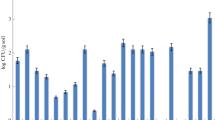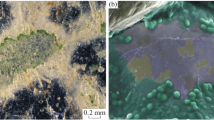Abstract
The results of long-term investigations performed by researchers from the Department of Soil Biology at the Faculty of Soil Science of Moscow State University into one of the major functions of soil microorganisms—sustenance of the turnover of matter and energy in the biosphere—are discussed. Data on the population densities of soil microbes and on the microbial biomass in different types of soils are presented. The systemic approach has been applied to study the structural-functional organization of the soil microbial communities. The role of eukaryotic and prokaryotic microorganisms in the carbon and nitrogen cycles is elucidated. It is argued that the high population density and diversity of microorganisms are necessary to maintain the turnover of chemical elements in terrestrial ecosystems. The viability of microbes stored in the soils is important. New data on the preservation and survival of bacteria in nanoforms are presented. It is shown that peatlands and paleosols are natural banks, where microbes can be preserved in a viable state for tens of thousands years.
Similar content being viewed by others
References
S. N. Winogradsky, Soil Microbiology (Nauka, Moscow, 1952) [in Russian].
A. V. Golovchenko, T. G. Dobrovolskaya, and D. G. Zvyagintsev, “Microbiological assessment of peatbog as the profile soil,” Vestn. Tomsk. Gos. Pedagog. Univ., Ser. Biol. Nauki, No. 4(78), 46–53 (2008).
A. V. Golovchenko, D. G. Zvyagintsev, A. V. Kurakov, and T. A. Semenova, “Abundance, diversity, viability, and factorial ecology of fungi in peatbogs,” Eurasian Soil Sci.46(1), 74–90 (2013).
A. V. Golovchenko, T. A. Pankratov, T. G. Dobrovolskaya, and O. S. Kukharenko, “Peat soils as a pool of bacterial diversity,” in The Role of Soils in the Biosphere, Tr. Inst. Ekol. Pochvoved., No. 10, 181–209 (2010).
V. A. Demkin, T. S. Demkina, T. E. Khomutova, and M. V. El’tsov, “Soil evolution and climate dynamics in dry steppes of the Privolzhskaya Upland during the last3500years,” Eurasian Soil Sci.45(12), 1095–1109 (2012).
T. G. Dobrovolskaya, Structure of Soil Bacterial Communities (Akademkniga, Moscow, 2002) [in Russian].
T. G. Dobrovol’skaya, A. V. Golovchenko, and D. G. Zvyagintsev, “Analysis of ecological factors limiting the destruction of high-moor peat,” Eurasian Soil Sci.47(3), 182–193 (2014).
T. G. Dobrovol’skaya, A. V. Golovchenko, L. V. Lysak, D. G. Zvyagintsev, and T. A. Pankratov, “Assessment of the bacterial diversity in soils: evolution of approaches and methods,” Eurasian Soil Sci.42(10), 1138–1147 (2009).
G. V. Dobrovol’skii and E. D. Nikitin, Ecological Functions of Soil (Moscow State University, Moscow, 1986) [in Russian].
G. V. Dobrovol’skii and M. M. Umarov, “Soil, microorganisms, and nitrogen in the biosphere,” Priroda (Moscow), No. 6, 15–22 (2003).
V. I. Duda, N. E. Suzina, V. N. Polivtseva, and A. M. Boronin, “Ultramicrobacteria: formation of the concept and contribution of ultramicrobacteria to biology,” Microbiology (Moscow)81(4), 379–390 (2012).
D. G. Zvyagintsev, Soil and Microorganisms (Moscow State University, Moscow, 1987) [in Russian].
D. G. Zvyagintsev, I. P. Bab’eva, T. G. Dobrovol’skaya, G. M. Zenova, and L. V. Lysak, “Vertical layer structure of microbial communities of forest biocenoses,” Mikrobiologiya62(1), 5–36 (1993).
D. G. Zvyagintsev, D. A. Gilichinskii, S. A. Blagodatsky, E. A. Vorob’eva, G. M. Khlebnikova, A. A. Arkhangelov, and N. N. Kudryavtseva, “Storage duration of microorganisms in permafrost sedimentary rocks and buried soils,” Mikrobiologiya,54(1), 155–161 (1985).
D. G. Zvyagintsev,, T. G. Dobrovol’skaya, I. P. Bab’eva, G. M. Zenova, L. V. Lysak, and O. E. Marfenina, “The role of microorganisms in biogeocenotic soil functions,” Pochvovedenie, No. 6, 63–77 (1992).
D. G. Zvyagintsev,, T. G. Dobrovol’skaya, I. P. Bab’eva, G. M. Zenova, L. V. Lysak, and O. E. Marfenina, “The role of microorganisms in biogeocenotic soil functions,” in Structural and Functional Role of Soils and Soil Biota in the Biosphere (Nauka, Moscow, 2003), pp. 115–124.
G. M. Zenova, M. S. Dubrova, and D. G. Zvyagintsev, “Structural-functional specificity of the complexes of psychrotolerant soil actinomycetes,” Eurasian Soil Sci.43(4), 447–452 (2010).
A. G. Kudinova, L. V. Lysak, V. S. Soina, N. S. Mergelov, A. V. Dolgikh, and I. G. Shorkunov, “Bacterial communities in the soils of cryptogamic barrens of East Antarctica (the Larsemann Hills and Thala Hills oases),” Eurasian Soil Sci.48(3), 276–287 (2015).
V. Yu. Litvin, A. L. Gintsburg, V. I. Pushkareva, and Yu.M. Romanova, “Reversible transition of pathogenic bacteria into the rest (nonculturable): ecological and genetic mechanisms,” Vestn. Ross. Akad. Med. Nauk, No. 1, 7–13 (2000).
L. V. Lysak, M. S. Kadulin, I. A. Konova, E. V. Lapygina, A. V. Ivanov, and D. G. Zvyagintsev, “Population number, viability, and taxonomic composition of the bacterial nanoforms in iron-manganic concretions,” Eurasian Soil Sci.46(6), 668–675 (2013).
L. V. Lysak, E. V. Lapygina, I. A. Konova, and D. G. Zvyagintsev, “Population density and taxonomic composition of bacterial nanoforms in soils of Russia,” Eurasian Soil Sci.43(7), 765–770 (2010).
L. V. Lysak, E. V. Lapygina, M. S. Kadulin, and I. A. Konova, “Number, viability, and diversity of the filterable forms of prokaryotes in sphagnum highmoor peat,” Biol. Bull.41(3), 228–232 (2014).
N. A. Manucharova, Hydrolytic Prokaryotic Complexes of Terrestrial Ecosystems (Universitetskaya Kniga, Moscow, 2014) [in Russian].
O. E. Marfenina, E. V. Gorbatovskaya, and M. V. Gorlenko, “Mycological characterization of the occupation deposits in excavated medieval Russian settlements,” Microbiology (Moscow)70(6), 738–742 (2001).
T. G. Mirchink, Soil Mycology (Moscow State University, Moscow, 1988) [in Russian].
I. E. Mishustina, “Nanobiology of the ocean,” Biol. Bull.31(5), 495–497 (2004).
D. I. Nikitin, “Application of electron microscopy for analysis of soil suspensions,” Pochvovedenie, No. 6, 86–91 (1964).
L. M. Polyanskaya, V. V. Geidebrekht, A. L. Stepanov, and D. G. Zvyagintsev, “Distribution of population and biomass within the profiles of zonal types of soils,” Pochvovedenie, No. 3, 322–328 (1995).
L. M. Polyanskaya, A. V. Golovchenko, and D. G. Zvyagintsev, “Microbial mass in soils,” Dokl. Akad. Nauk344(6), 846–848 (1995).
Yu. I. Preis, O. R. Sorokovenko, and I. V. Kur’ina, “Reconstruction of water balance in southern taiga bogs of Western Siberia in the Holocene using the data on the Temnoe peat mining site,” in Proceedings of the VII All-Russia Symposium with International Participation “Environment and Climate Monitoring KOSK–2010” (Siberian Branch, Russian Academy of Sciences, Tomsk, 2010), pp. 121–123.
A. V. Rappoport, L. V. Lysak, O. E. Marfenina, A. A. Rakhleeva, M. N. Stroganova, V. A. Terekhova, and N. V. Makarova, “Soil-ecological studies in botanical gardens (by example of Moscow and St. Petersburg),” Byull. Mosk. O-va. Ispyt. Prir., Otd. Biol.118(5), 45–56 (2013).
V. S. Soina, L. V. Lysak, I. A. Konova, E. V. Lapygina, and D. G. Zvyagintsev, “Study of ultramicrobacteria (nanoforms) in soils and subsoil deposits by electron microscopy,” Eurasian Soil Sci.45(11), 1048–1056 (2012).
A. L. Stepanov, Microbial Release and Consumption of Greenhouse Gases in Soils (Moscow State University, Moscow, 2009) [in Russian].
M. M. Umarov, A. V. Kurakov, and A. L. Stepanov, Microbial Transformation of Nitrogen in Soil (GEOS, Moscow, 2007) [in Russian].
Activity of Microbial Complexes in Upper Peatbogs: Analysis of the Reasons of a Slow Decomposition of Peat (KMK, Moscow, 2013) [in Russian].
N. A. Khotinskii, Holocene of Northern Eurasia (Nauka, Moscow, 1977) [in Russian].
I. Yu. Chernov, T. G. Dobrovol’skaya, and L. V. Lysak, “Soil and microbial diversity,” in The role of Soil in Formation and Preservation of Biological Diversity (KMK, Moscow, 2011), pp. 22–85.
I. Yu. Chernov, T. G. Dobrovol’skaya, and L. V. Lysak, “Problems and prospects of studies of biodiversity of soils,” in The role of Soil in the Biosphere and Human Life (Moscow State University of Forestry, Moscow, 2012), pp. 35–69.
M. J. Carlile, S. C. Watkinson, and G. W. Gooday, The Fungi (Academic, San Diego, 2001).
K. H. Domsh, W. Gams, and T. H. Anderson, Compendium of Soil Fungi (IHW-Verlag et Verlagsbuchhandlung, 2007).
N. A. Manucharova, E. M. Kol’tsova, A. L. Stepanov, E. V. Demkina, V. A. Demkin, and G. I. El’Registan, “Comparative analysis of the functional activity and composition of hydrolytic microbial complexes from the lower Volga barrow and modern chestnut soils,” Microbiology (Moscow)83(5), 674–683 (2014).
N. Panikov, “Contribution of nanosized bacteria to the total biomass and activity of a soil microbial community,” Adv. Appl. Microbiol. 57, 245–296 (2005).
Author information
Authors and Affiliations
Corresponding author
Additional information
Original Russian Text © T.G. Dobrovol’skaya, D.G. Zvyagintsev, I.Yu. Chernov, A.V. Golovchenko, G.M. Zenova, L.V. Lysak, N.A. Manucharova, O.E. Marfenina, L.M. Polyanskaya, A.L. Stepanov, M.M. Umarov, 2015, published in Pochvovedenie, 2015, No. 9, pp. 1087–1096.
Rights and permissions
About this article
Cite this article
Dobrovol’skaya, T.G., Zvyagintsev, D.G., Chernov, I.Y. et al. The role of microorganisms in the ecological functions of soils. Eurasian Soil Sc. 48, 959–967 (2015). https://doi.org/10.1134/S1064229315090033
Received:
Published:
Issue Date:
DOI: https://doi.org/10.1134/S1064229315090033




